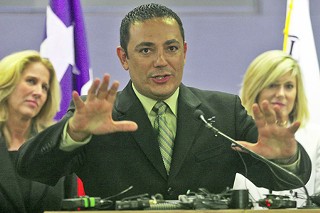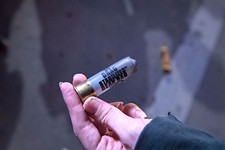DOJ: 160 Ways Austin Police Can Improve
Department of Justice issues recommendations for improving APD
By Jordan Smith, Fri., Jan. 9, 2009
The U.S. Department of Justice has made 160 recommendations to improve Austin Police Department policies and procedures, as part of the ongoing federal investigation of department practices. APD Chief Art Acevedo said Jan. 5 that his department has implemented, or is in the process of implementing, the majority of the recommendations, outlined in a 50-page letter of "technical assistance" delivered to city officials late last month.
A majority of the DOJ recommendations involve policies governing police use of force. The DOJ also makes substantive suggestions on how citizen complaints should be classified and reviewed by Internal Affairs and recommendations that emphasize the need for comprehensive and ongoing police training.
The DOJ has been reviewing APD's policies and practices since mid-2007, when it agreed to look into complaints made in 2004 by Nelson Linder of the Austin NAACP and Jim Harrington with the Texas Civil Rights Project, who were concerned about the use of excessive force against minority suspects, including in the high-profile shooting deaths of Sophia King in 2002 and Jesse Lee Owens in 2003. Linder and Harrington amended their complaint in 2005 to include details of the Midtown Live nightclub fire that sparked the "burn baby burn" fiasco (when responding officers and dispatchers exchanged celebratory messages about the fire that were viewed on in-car data terminals by a throng of bystanders). In March 2005, then-Chief Stan Knee and City Manager Toby Futrell signed on to the request for an inquiry, telling U.S. Attorney Johnny Sutton they would welcome the outside review. (The DOJ told officials it would come to Austin to investigate the complaints just one day after the fatal shooting of Kevin Brown by APD Sgt. Michael Olsen, and a review of that incident was quickly added to the DOJ's investigation.)
The DOJ says new APD policies (written since Acevedo took over in 2007) have addressed some deficiencies, but agency officials note that there are still areas that need improvement. The department's use-of-force policy (reborn under Acevedo as the "response to resistance" policy) includes better language, for example, but still fails to define "lethal force" in a manner that could include the use of a weapon other than a firearm. Regarding Tasers, the DOJ says, the current policy allows for their use against "potentially" violent suspects, which the DOJ says is "too broad," Shanetta Cutlar, chief of the DOJ's Special Litigation Section of the Civil Rights Division, wrote in the letter. The agency also notes that APD policy doesn't provide officers any guidance on when to use oleoresin capsicum spray (commonly, pepper spray), how much to use, or how to select "targets" for its use. "This," Cutlar wrote, "is problematic."
The DOJ also recommends that APD rework its process for classifying and investigating citizen complaints, which now "is needlessly complex and fraught with opportunities to apply subjective judgment," Cutlar wrote.
The department has made numerous policy changes under Acevedo, including many now being made by the DOJ. All told, Acevedo said at a Monday press conference, APD has already implemented about 25% of the DOJ's suggested changes, and the "vast majority of the rest" are currently being worked on.
The DOJ's review isn't yet complete. The agency is still investigating specific use-of-force incidents – including several police shooting deaths. While Acevedo expressed confidence that the DOJ will give the city's police a clean bill of health, Linder says the fact the DOJ decided to investigate is telling. Going forward, Linder said he would like to see the department "embrace" the DOJ suggestions and "make sure these things are enforced." Indeed, Harrington said that the policy recommendations are not minor and that while the APD is one of the better departments in the country, there is "a lot of room to grow."
Got something to say on the subject? Send a letter to the editor.











